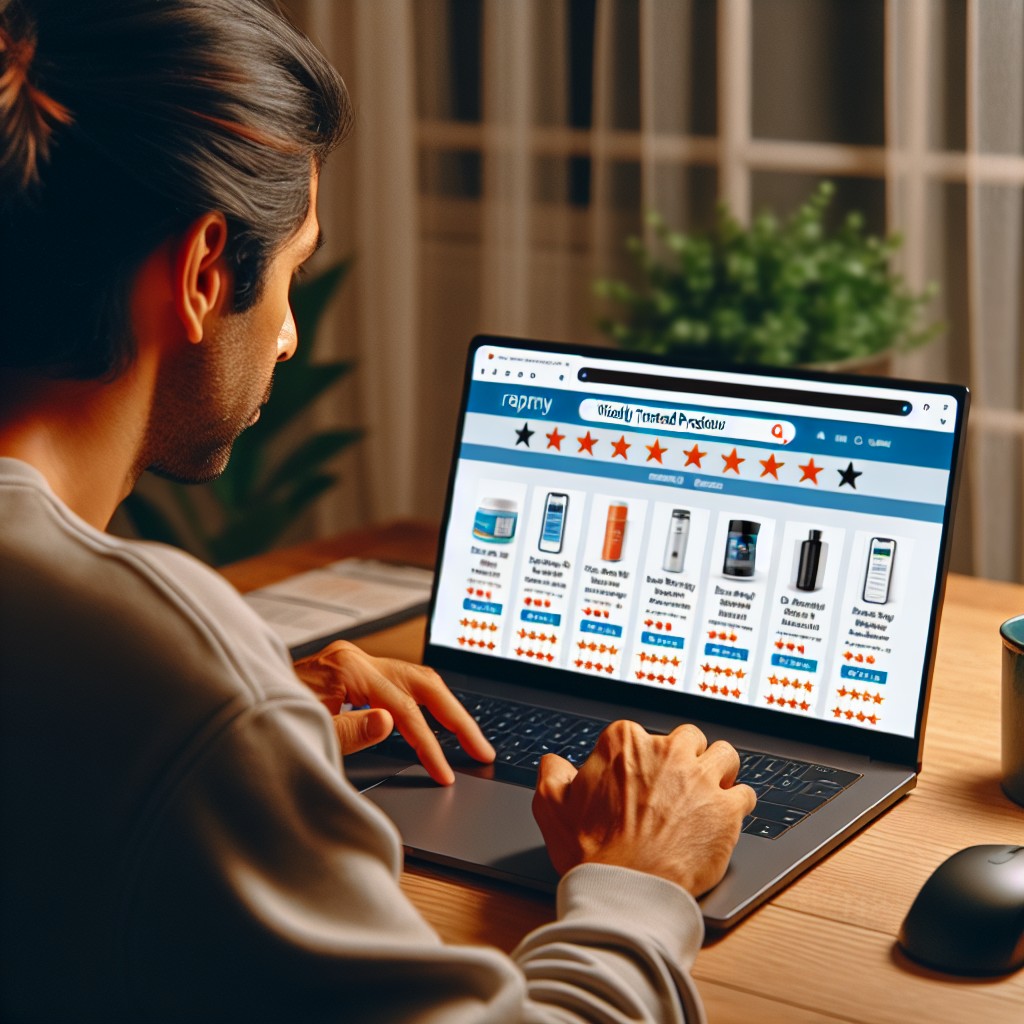Last updated on
One of the best ways to get reliable information about a product is to read verified customer reviews and product ratings on validated shopping platforms.
One of the most effective ways to gain reliable information about a product is through comprehensive online research, a practice consistently recommended by home decorating experts. A strategic approach requires studying reviews from multiple online platforms, such as ecommerce websites, forums, blogs, and social media platforms.
These sources often present a balanced view of the product’s features, performance, and potential drawbacks. Additionally, look out for professional assessments from trustworthy online publications that specialize in product critiques. Remember, a product’s specification sheet won’t tell you everything; nothing beats the input from real users and experts to tell you if a toaster can consistently brown your bread or a paint truly offers double coverage.
Let’s dive deeper to understand the art of effective product research.
Key takeaways:
- Read verified customer reviews and product ratings on validated shopping platforms.
- Utilize expert reviews for in-depth analysis and benchmark comparisons.
- Check the manufacturer’s information for detailed specifications and warranty coverage.
- Look for third-party testing and certifications for unbiased endorsements.
- Use comparison websites for filtering options and community insights.
Table of Contents
Customer Reviews

When diving into customer reviews, discern a pattern of experiences to gauge the product’s performance. Look beyond the star ratings; the substance lies in the detailed narratives where users share specific pros and cons. Spot recurring themes, whether praises for durability or concerns over functionality, as these can signal consistent strengths or issues.
Be mindful of the context in which the product was used, as this can influence the relevance of the feedback to your situation. For instance, a negative review based on improper use may not accurately reflect the product’s quality.
Consider the dates of the reviews to ensure the information is up-to-date. Products can evolve, and manufacturers may address earlier flaws highlighted by customers.
Quantity can also influence reliability. A product with hundreds of reviews will offer a more comprehensive understanding than one with just a handful.
Lastly, watch out for fabricated reviews. Overly positive language without specifics or multiple similar reviews posted in a short timeframe could indicate manipulation. Trustworthy platforms often have measures to authenticate reviews and mark those from verified purchasers.
Expert Reviews

Professionals in the industry often provide a wealth of insight when evaluating products. Their assessments are typically based on years of experience and a deep understanding of what to look for in terms of quality and functionality.
- Depth of Analysis: Expert reviewers delve into the nitty-gritty, examining build quality, performance, and ease of use.
- Benchmark Comparisons: They may compare the product against industry standards or similar items to give context to their evaluation.
- Technical Perspective: With their knowledge, they can finely dissect technical specifications and translate them into layman’s terms.
- Objective Testing: Experts often perform standardized tests to measure a product’s capabilities impartially.
Seeking out these reviews can give you a comprehensive perspective of a product before committing to a purchase.
Manufacturer’s Information

Diving directly into the first-hand source, manufacturer’s information is often detailed and reliable. When considering this resource, it’s beneficial to:
- Look for specification sheets and product manuals, which provide technical details that can help you understand the product’s capabilities and limitations.
- Explore the FAQs section where common concerns are addressed, offering a better understanding of potential issues and their solutions.
- Review warranty information to gauge the manufacturer’s confidence in their product and the support you can expect post-purchase.
- Check for any verified sustainable practices or certifications that align with the brand’s advertised values and commitment to quality.
- Examine the contact information provided for customer support, acknowledging that accessible and responsive service is indicative of a reputable company.
Remember, while manufacturer’s data is essential, it’s also curated to put the product in the best light, so cross-referencing with independent reviews and user experiences is recommended for a balanced view.
Third-Party Testing & Certification

Third-party testing and certification serve as unbiased endorsements of a product’s quality, safety, and performance. Agencies not affiliated with the manufacturer conduct rigorous assessments based on predetermined industry standards.
By looking out for recognized certifications, you can ensure that the product meets specific criteria:
- Quality Assurance: Independent testing often verifies that the item is made according to industry and regulatory standards, signaling a commitment to quality.
- Safety Guarantees: Certifications like UL, CE, and CSA indicate that a product is safe for use, having passed critical safety checks.
- Environmental Impact: Eco-labels such as ENERGY STAR or FSC (Forest Stewardship Council) certify environmental friendliness, showing that a product is energy-efficient or sustainably sourced.
- Performance Metrics: Products that have earned performance-based certifications have been vetted for operational efficiency, meeting benchmarks for effectiveness.
- Material Authenticity: Certifications can attest to the genuineness of materials, such as organic textiles or conflict-free minerals, providing transparency.
Remember to check for the latest certifications, as standards can evolve. Products with up-to-date certifications are more likely to offer the latest in safety, quality, and performance.
Comparison Websites

Navigating comparison websites can be like having a personal shopping assistant. They distill vast amounts of data into digestible, side-by-side comparisons, saving time and effort. Here’s how they enhance the product research process:
- Filtering Options: Select attributes that align with your priorities to narrow down choices. Whether it’s price, brand, or specific features, these sites simplify finding what you’re looking for.
- Price Tracking: Many of these platforms provide historical data on pricing, helping you determine if now is a good time to buy or if waiting for a sale might be prudent.
- Rating Systems: Often, products are ranked by average customer ratings, giving you a quick sense of general satisfaction levels.
- Pros and Cons: These sites typically list advantages and disadvantages, making it easier to weigh options.
- Community Insights: User comments can give context to ratings, providing real-world experiences and potential red flags.
Remember that some comparison websites may have partnerships with manufacturers or receive commissions on sales. Look to ensure their evaluations are objective and comprehensive.
Social Media & Forums

Social media platforms and online forums bring together a community of people with similar interests, including product users who share real-life experiences. Through these channels, you can gain insights that may not be available from professional reviews or product descriptions.
- Look for groups or pages dedicated to the product or brand.
- Pay attention to the frequency of certain complaints or praises to gauge common experiences.
- Ask questions within these communities for more personalized feedback.
- Notice if the manufacturer engages with customers and how they handle concerns.
- Be wary of fake reviews or promotions—look for genuine, detailed user experiences.
- Utilize platforms like Reddit or Quora where you can find in-depth discussions.
- Consider the context of the feedback, as individual preferences may differ.
Monitoring these conversations can provide a more nuanced understanding of a product’s performance in everyday use.
In-Person Demos or Trials

Experiencing a product first-hand before purchase can be invaluable. Retail stores often provide demonstrations or trial periods, allowing you to assess the item in a real-world setting. Pay attention to:
- Ease of Use: Can you operate it comfortably? Is the interface user-friendly? This is your chance to interact with the product and gauge its intuitiveness.
- Performance: Does it function as promised? Are the results satisfactory? Observe whether it meets or exceeds the performance you expect.
- Quality: Assess the materials and build. Do they seem durable? Touch and feel can reveal much about an item’s longevity.
- Features: Are all advertised features present and working? Ensure that essential functions are tested, and assess any additional features for their practicality.
- Size and Fit: Will it suit your space or requirements? Bring measurements and ensure the product fits both physically and aesthetically within your intended area.
Leverage this direct interaction to clarify doubts and make an informed decision. Remember to ask the sales team questions, as they can provide valuable insights and address any concerns you might have.
The Importance of Research

Thorough research ensures you are well-informed about the product’s features, performance, and potential drawbacks. It reduces the risk of post-purchase dissatisfaction and the need for returns or exchanges.
Here are some points that highlight the concept of meticulous product research:
- It identifies if the product fulfills your specific needs and preferences, rather than basing your decision on generic information.
- It helps compare similar products, allowing you to discern which offers the best value for your money.
- It uncovers any common issues or defects reported by current users, which might not be immediately apparent.
- It provides insights into the longevity and durability of the product through longevity reviews and user experiences.
- It acquaints you with the manufacturer’s customer service quality and warranty coverage, which are crucial post-purchase considerations.
Avoiding Buyer’s Remorse

To sidestep the disappointment that often follows an ill-considered purchase, thorough research is your ally. Evaluating products against your specific needs and expectations plays a crucial role. Here are a few pointers to help you make informed decisions:
- Set a Clear Budget: Know what you’re willing and able to spend to prevent overspending on features you don’t need.
- Identify Your Must-Haves: Make a list of features that are non-negotiable for your satisfaction.
- Check Return Policies: Understanding the return policy can provide a safety net if the product doesn’t meet your expectations.
- Don’t Succumb to Hype: Look beyond marketing and seek facts about a product’s performance and durability.
- Time Your Purchase: Sales events can offer the best value for money, but ensure the discounted products still meet your criteria.
- Consider Future Costs: Be aware of any additional expenses, such as accessories or maintenance, that may be required.
Informed choices not only bring peace of mind but also affirm that you’ve invested wisely.
Identifying Quality and Value

Determining a product’s quality and value hinges on assessing materials, build, brand reputation, and price-to-performance ratio:
Materials and Build: Examine the construction and materials used; products made with high-quality substances generally last longer and perform better.
Brand Reputation: Research the brand’s history for consistency in delivering high-quality products.
Price-to-Performance Ratio: Evaluate whether the product’s cost aligns with its features, durability, and overall performance.
Longevity: Consider products that offer extended lifespans or warranties as an indicator of the manufacturer’s confidence in its quality.
User Experience: Read through customer feedback to see if the general consensus matches the product’s claimed attributes and value proposition.
It’s crucial to weigh these elements against personal needs and budget to make an informed decision about a product’s true worth.
Define Your Needs and Criteria

Identifying personal requirements and specific product features is crucial before delving into any research. Consider the following points to narrow down your search:
- Purpose and Functionality: What is the primary use of the product? Does it need to have multifunctional capabilities or is a single-purpose item sufficient?
- Budget: Establish a price range that is affordable and realistic, keeping in mind long-term value over short-term savings.
- Size and Space: Measure the area where the product will be placed to ensure it fits comfortably and maintains the aesthetics and functionality of the space.
- Aesthetic Preferences: Decide on preferred colors, materials, and design styles that will complement existing decor or preferred tastes.
- Performance and Quality: Determine the level of quality and performance you expect, which might influence the brands or models to consider.
- Features: List any extra features that are important to you, such as energy efficiency, smart technology integration, or ergonomic design.
By setting clear priorities and desired characteristics, you can effectively filter out irrelevant options and focus on products that truly meet your needs.
Utilize Trusted Sources

When gathering product information, prioritize reliable sources to ensure accuracy and completeness:
- Industry publications and well-regarded consumer magazines often provide in-depth, unbiased reviews.
- Official brand websites should be visited for detailed product specifications and warranty information.
- Government or industry watchdog groups can offer insights and safety ratings, ensuring that the product meets stringent standards.
- Libraries and consumer research centers can be treasure troves of comprehensive studies on a wide range of products.
- Accredited professionals, such as interior designers or industry experts, can give informed opinions based on experience and knowledge.
By consulting these sources, you’ll equip yourself with credible data, steering clear of misleading advertising or biased user comments that could distort your perception and influence your purchasing decision.
Check Product Specifications

When delving into product specifications, it’s crucial to scrutinize the details that align with your needs. Look at the dimensions to ensure a good fit in your intended space.
Examine the material’s durability, particularly if the item is for daily use. Energy efficiency ratings are also essential for electronic appliances, potentially saving you money in the long run.
Connectivity features are another aspect to consider for tech products, ensuring compatibility with your existing devices. Pay attention to the warranty period, as it reflects the manufacturer’s confidence in their product and offers you peace of mind.
Understanding these elements will aid in making an informed decision that matches your criteria for quality and functionality.
Look for Long-Term Reviews

Long-term reviews offer insights into a product’s durability, performance over time, and any potential longevity issues that might not be apparent in initial feedback. Here’s how to glean valuable information from these evaluations:
- Focus on comments that mention usage over several months or years.
- Pay attention to updates where users revise their initial impressions based on extended use.
- Look for patterns in the reports regarding wear and tear or maintenance needs.
- Consider the consistency of a product’s performance: does it meet the user’s needs as well as it did on day one?
- Observe any changes in customer support or warranty service experiences over time.
These details can provide a realistic expectation of how a product ages, helping you make a decision that aligns with your long-term needs.
Seek Recommendations From Trusted Contacts

Tapping into the knowledge and experience of friends, family, and colleagues can lead to insights that are both personal and trustworthy. These individuals have no vested interest in the product and will often provide candid feedback. To harness their collective wisdom effectively:
- Ask for specifics: Rather than a general thumbs-up or down, request details about their experience with the product.
- Consider relevance: Weigh their opinions against how closely their needs or situation matches yours.
- Evaluate expertise: Someone who’s used several similar products might offer a richer perspective compared to a casual user.
- Request photos or a demonstration: If they’re nearby, a firsthand look can provide information beyond just words.
- Discuss after-sales service: Find out about their experiences with customer support and warranties.
Remember, word-of-mouth recommendations can yield invaluable insights that might not be captured in online reviews or expert opinions.
Watch Video Reviews

Visual demonstrations provide a clearer understanding of how a product functions in a real-world setting. Here are a few points to consider when watching video reviews:
- Identify reputable reviewers who provide comprehensive testing results and unbiased opinions.
- Focus on videos that show the product being used in various conditions to gauge its versatility and durability.
- Pay attention to the details that matter to you, such as ease of use, build quality, and specific features.
- Watch for any potential issues or drawbacks mentioned by reviewers that may not be immediately obvious from a product description or image.
- Note how the product compares to others in the same category to help with your decision-making process.
Consider the Manufacturer’s Reputation

Assessing a manufacturer’s standing in the market can provide vital clues about product reliability and quality. Well-established brands often have a history of customer satisfaction, robust quality control measures, and consistent performance.
To gauge a company’s reputation:
- Examine their history: How long has the company been in business? A lengthy track record can indicate experience and resilience in the market.
- Look for awards and recognition: Accolades from industry bodies or consumer groups can affirm a company’s commitment to excellence.
- Read about their customer service: A responsive and helpful customer care team is essential, especially if you encounter issues or have questions post-purchase.
- Assess their involvement in industry advancement: Active participation in technological innovation and environmental stewardship can reflect on the quality and sustainability of their products.
- Investigate any recalls or controversies: These can signal potential issues with product safety or corporate ethics.
Remember, a brand’s reputation should not solely drive your buying decision but it can be a helpful component in the larger scheme of evaluating products.
FAQ
Which housing option gives you more freedom?
Detached homes typically offer homeowners the most freedom for improvements and renovations.
Which payment option could have interest charged to you credit card check cash debit card?
The payment option that could potentially incur interest charges is a credit card.
Which of the following is not a useful strategy when making an informed purchase?
The act of buying a product solely based on an influencer’s endorsement is not a useful strategy when making an informed purchase.
Which method of payment actually is a form of borrowing money that needs to be paid back later?
The method of payment that consists of borrowing money to be paid back later is the use of credit.
What are the significant factors to consider when comparing product reviews?
Significant factors to consider when comparing product reviews include the credibility of the reviewer, the consistencies and discrepancies in the feedback, the number of reviews, and the ratio of positive to negative reviews.
How can consumer feedback impact your purchasing decision?
Consumer feedback can significantly impact your purchasing decision by providing first-hand user experiences that help you evaluate the product’s quality, functionality, and reliability.
Which digital platforms are generally trusted for authentic product specifics and customer reviews?
Amazon, eBay, and Best Buy are reliable digital platforms known for providing authentic product specifications and customer reviews.




